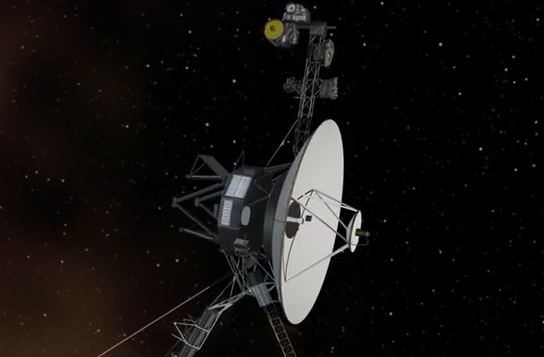(单词翻译:单击)
In Star Trek, if the Enterprise needed to talk to Starfleet Command,
在《星际迷航》电影中,如果“进取号”需要与星际舰队司令部通话,
they could just send a quick message or have a conversation in real time, even if they were light-years away from each other.
他们可以即时发送一个短信息或进行一次通话,即使他们距离彼此有几光年之遥。
But like most things in Star Trek, that's not how it works in real life.
但《星际迷航》里的大多数事物在现实生活中并不是这样工作的。
For one thing, the waves that carry messages can only travel as fast as the speed of light,
首先,信息波的最快速度就是光速,
or about 300 million meters per second and that may sound really fast, but space is also really big.
也就是3亿米每秒,这听起来可能很快了,但太空也很广阔。
And as a spacecraft gets farther away, it becomes harder for us to detect its signal, so we need bigger and bigger detectors.
随着宇宙飞船越来越远,探测它的信号变得越来越难,所以我们需要越来越大的探测器。
Since we're still focusing on exploring our own star system, that's not a big deal right now.
因为我们仍然专注于探索我们自己的恒星系统,所以这不是什么大事。
If we ever sent a probe to another star, though, we'd need a detector the size of a city to get any data from it.
但如果我们要探测另一个恒星的话,就需要一个城市大小的探测器来获取数据了。
But scientists are already working on a solution for that!
科学家们已经在研究解决这个问题的方法了。
And it might involve using the sun as a giant lens to strengthen the signal.
这可能需要利用太阳作巨大的透镜来增强信号。
When you think of a lens, you might think of a curved piece of glass that can magnify objects, like a telescope.
当你思考透镜时,你可能会想到一块曲面玻璃,它可以放大物体,就像望远镜一样。
But the sun actually creates a lens of its own, called a gravitational lens,
但太阳实际上创造了一个自己的透镜,名为引力透镜,
because huge objects like stars have so much gravity that they warp and curve space around them.
因为恒星这样的巨大物体引力非常大,以至于周围的空间发生弯曲。
Isn't that just the coolest thing in the universe?
这难道不是宇宙中最酷的东西吗?
When those stars curve space, any radiation traveling toward them, like light from a distant galaxy, gets curved, too.
当这些恒星弯曲空间时,任何朝向它们的辐射如遥远星系的光,也会发生弯曲。
The star bends the light around itself like a giant lens, and if you looked at the star from a distance,
恒星如一个巨大透镜将光线弯曲,如果你从远处看这颗恒星,
you would see a magnified, distorted ring of light around it.
你会看到它周围有一个放大而扭曲的光环。
It sounds kind of complicated, because it is.
这听起来有点儿复杂,因为事实就是如此。
But gravitational lenses are super useful
引力透镜非常有用,
because they allow us to see distant objects that would normally be blocked by big stars or clusters of galaxies.
因为它们能让我们看到遥远的物体,通常那些物体都被大星群或星系团挡住了。
And because gravitational lenses bend any kind of radiation, not just visible light,
因为引力透镜能弯曲任何种类的辐射,而不仅仅是可见光,
they could also be used to magnify radio waves or other communication signals!
它们也可以用来放大无线电波或其他通信信号!
If a spacecraft around another star shot a message right at our sun,
如果围绕另一颗恒星飞行的宇宙飞船向我们的太阳发出一条信息,
the sun's gravitational lens would magnify and boost the signal so we could pick it up.
太阳的引力透镜就会放大和提高信号,这样我们就可以接收到信号了。
It wouldn't speed up the message, because the signal would already be traveling at the speed of light,
引力透镜不会加速信息的传播,因为信号已经是光速传播了,
but it would make it stronger, so we could send more data and detect it more easily.
但它可以加强信号,这样我们就可以发送更多的数据,探测起来也更容易了。
We have a whole lot of work to do before we're ready for that, though.
不过,在这样做之前,我们有许多筹备工作。

The main problem is that we wouldn't be able to just use a big receiving dish on Earth like we do with missions today.
主要问题是我们不能和处理现在的任务一样,仅在地球上用一个大卫星接收器接收信号。
Like others lenses, the lens created by the sun has a focal point, a place where all of the waves of radiation come together.
和其他透镜一样,引力透镜也有焦点,所有的辐射都会聚集在那一点上。
The sun actually has a bunch of focal points, or a focal line,
太阳实际上有一串焦点,或者说是焦线,
but the closest place to pick up a signal is over 80 billion kilometers away, more than 550 times the distance from the Earth to the sun.
但最接近信号的位置也在800亿公里之外,是日-地距离的550多倍。
Compare that to the Voyager 1 probe, which is about 21 billion kilometers away.
相比之下,“旅行者1号”探测器大约有210亿公里远,
That's the farthest we've ever sent anything into space, and it took 40 years to get there.
这是我们进行太空发射的最远距离,它花了40年才到达那里。
And to use the sun for long-distance communication, it might actually be even better to go farther than 80 billion kilometers,
而为了利用太阳进行远距离通信,它甚至可能要超过800亿公里。
because that would help us avoid solar flares and other interference from the sun that could scramble communications signals.
因为这将帮助我们避免太阳耀斑和其它干扰,这些可能会扰乱通信信号。
On the other hand, if we're at the point where we're able to send missions all the way to other stars,
另一方面,如果我们能直接发射探测任务到其他恒星上,
maybe getting to 80 billion kilometers out wouldn't be much of a problem.
也许达到800亿公里就不是什么大问题了。
We'd also have to figure out how to reconstruct the message we received, though.
不过,我们也必须考虑如何修复我们收到的信息。
The signal would be warped by the sun's gravity, so we'd have to do a lot of math to make sense of the jumbled messages we got.
信号会被太阳引力弯曲,所以我们需要做很多数学运算来弄清楚我们得到的杂乱信息。
On top of that, we'd only be able to get messages from spacecraft on the exact opposite side of the sun from our receiving probe.
除此之外,我们只能从太阳正对面的航天器接收装置接收消息。
And if we wanted to send a message instead of just receiving one,
如果我们想要发射信息而不是接收的话,
we'd also have to get the faraway spacecraft somewhere on the sun's focal line so it could pick up our signal,
我们还得让遥远的宇宙飞船飞到太阳焦距上,这样它就能收到我们的信号了。
which is pretty limiting when you're trying to explore strange new worlds.
当你试图探索陌生的新世界时,非常受限。
So we have our work cut out for us.
所以我们就不考虑它了。
But some astronomers think it could definitely happen,
但一些天文学家非常肯定它会发生,
and that one day, we might have a huge interstellar communications network using gravitational lenses across the galaxy.
也许有一天,我们有一个巨大的星际通信网络,能利用引力透镜穿透银河系。
Astronomers can't help but dream big.
天文学家们志向远大。
But even if we never figure out how to visit other stars, we could at least use the sun's gravitational lens as a big telescope.
即使我们不知道如何去拜访其他的恒星,我们至少可以用太阳的引力透镜作大型望远镜。
Instead of translating messages and getting the probes in the right spots,
我们不需要在正确区域翻译信息和做调查,
we could just use the lens to get a close-up view at whatever is directly behind the sun, like exoplanets or distant galaxies.
而是利用透镜直接近距离观察太阳背后的事物,如地外行星和遥远的星系,
It would be like having a telescope with a lens more than a million kilometers across!
它就像一个透镜超过一百万公里的望远镜!
But either way, we're definitely not ready to use the sun as a gravitational lens for anything yet, let alone interstellar Snapchat.
但无论如何,我们肯定还没有准备好利用太阳作引力透镜观察东西,更不用说星际“色拉布”了。
Thanks for watching this episode of SciShow Space,
感谢您收看本期的太空科学秀,
brought to you by our awesome patrons on Patreon who make everything at SciShow possible.
在了不起的“Patreon”帮助下,我们为您带来了这一切。
If you'd like to help us keep explaining ideas like this, you can go to patreon.com/scishow.
如果你愿意帮助我们继续解释此类想法,可以登录patreon.com/scishow。
And for more episodes about the universe and the sun which makes everything we do possible
我们尽一切可能制作更多的宇宙和太阳的内容,
also, you can go to youtube.com/scishowspace and subscribe.
你也可以登录youtube.com/scishowspace点击订阅。


